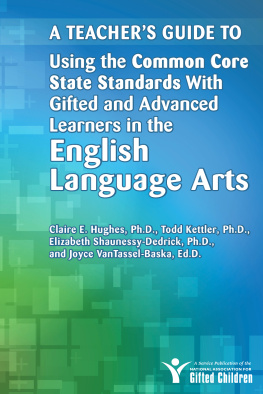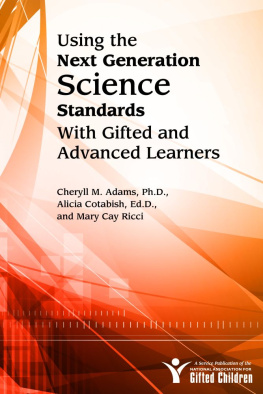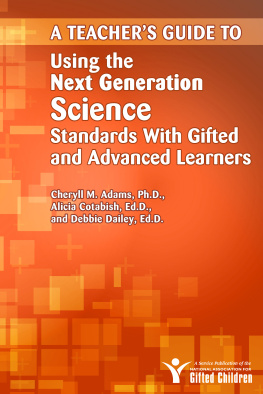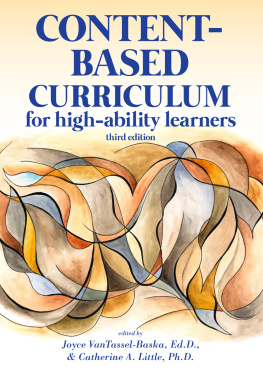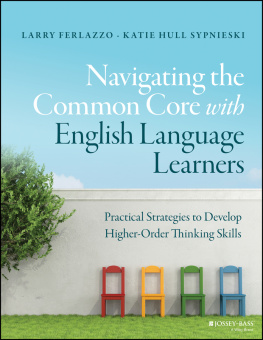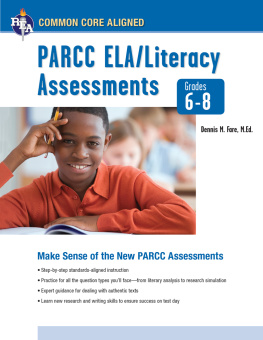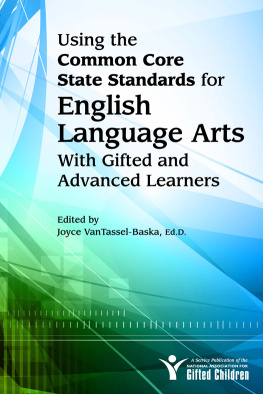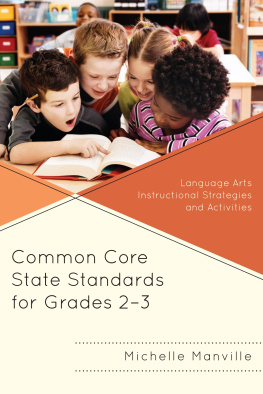Acknowledgements
Many people have assisted with the efforts in developing this book. They include the leadership of NAGC, the NAGC Professional Standards Committee, reviewers, NAGC staff, and experts who were a part of the development of the other books in this series on using the Common Core State Standards with gifted and advanced learners.
We would like to thank Paula Olszewski-Kubilius, NAGC president, and the NAGC Board, who have understood the urgency for responding to the Common Core State Standards and the gifted education communitys need to have a voice in their implementation. From the beginning, the NAGC Professional Standards Committee also has been actively involved in providing the framework, expertise, and support for this book. Moreover, the NAGC leadership group also includes Nancy Green, executive director of the NAGC, and NAGC Association Editor Carolyn Callahan, who have supported the development process and the need for this book.
This book has also been strengthened through a rigorous review process. We want to thank these reviewers from the NAGC Publications Committee who took time to provide valuable advice and feedback and Felicia Dixon, Elizabeth Fogarty, William D. Keilty, Penny Kolloff, and Vicki Vaughn for their input on the manuscript. We also want to thank again the authors and contributors from the first book: Susan K. Johnsen, Jennifer L. Jolly, and Debra A. Troxclair.
Finally, the authors want to express a special thank you to Jane Clarenbach, Director of Public Education at the NAGC office, who has provided the needed energy in supporting the authors through the process and a critical eye in editing the many drafts of this book. She has shepherded this writing project with great diplomacy, tact, and endless amounts of patience.
| Claire Hughes |
| Todd Kettler |
| Elizabeth Shaunessy-Dedrick |
| Joyce VanTassel-Baska |
Appendix A
Definitions of Key Terms
Acceleration is a broad term used to describe ways in which gifted student learning may occur at a faster, more appropriate rate throughout the years of schooling. It refers to content acceleration through compacting and reorganizing curriculum by unit or year, grade skipping, telescoping 2 years into one, dual enrollment in high school and college or university, as well as more personalized approaches, such as tutorials and mentorships that also would be sensitive to the advanced starting level of these learners for instruction. Both Advanced Placement (AP) and International Baccalaureate (IB) at the high school level represent programs of study already accelerated in content. AP courses also may be taken on a fast track schedule earlier as appropriate.
Appropriate pacing refers to the rate at which material is taught to advanced learners. Because they are capable of mastering new material more rapidly than typical learners, appropriate pacing would involve careful preassessment and streamlining techniques to ensure that advanced learners are not bored with the material and are being adequately challenged. Note that although students might advance quickly through some material, they should also be given time to delve more deeply into topics of interest at appropriate advanced levels of complexity and innovation.
Assessment is the way to determine the scope and degree of learning that has been internalized by the student. For purposes of gifted education, the assessments must be matched to differentiated outcomes, requiring the use of authentic approaches like performance-based and portfolio-based assessment demands. Some assessments are already constructed and available for use, exhibiting strong technical adequacy and employed in research studies while others may be teacher-developed, with opportunities to establish interrater reliability among teachers who may be using them in schools. Care should be taken to use assessments that do not restrict the level of proficiency that students can demonstrate, such as above-grade-level assessments that allow for innovative and more complex responses.
Characteristics and needs of gifted learners is the basis for differentiating any curriculum area. In English language arts, verbally talented students learn to read early, talk in complex sentences, write coherent text, and become sensitive to language at an earlier stage of development than typical learners do. Because of this advanced readiness to engage with their world, their curriculum diet may be accelerated and should be advanced, rich in experiences for increasing complexity and depth, and open-ended to allow for creative manipulation of ideas and concepts.
Complexity refers to a feature of differentiation that provides advanced learners more variables to study, asks them to use multiple resources to solve a problem, or requires them to use multiple higher order skills simultaneously. The degree of complexity may depend on the developmental level of the learner, the nature of the learning task, and the readiness to take on the level of challenge required.
Creativity and innovation are used to suggest that activities used with the gifted employ opportunities for more open-ended project work that mirrors real-world professional work in solving problems in the disciplines. The terms also suggest that advanced learners will be able to internalize the skills and habits of mind associated with being a creator or innovator in a chosen field of endeavor. Thus, creative thinking and problem-solving skills would be emphasized.
Curriculum is a set of planned learning experiences, delineated from a framework of expectations at the goal or outcome level that represents important knowledge, skills, and concepts to be learned. Differentiated curriculum units of study already have been designed and tested for effectiveness in language arts, or units may be developed by teachers to use in gifted instruction.
Differentiation of curriculum for gifted learners is the process of adapting and modifying curriculum structures to address these characteristics and needs more optimally. Thus curriculum goals, outcomes, and activities may be tailored for gifted learners to accommodate their needs. Typically, this process involves the use of the strategies of acceleration, complexity, depth, and creativity in combination.
Instruction is the delivery system for teaching that comprises the deliberate use of models, strategies, and supportive management techniques. For gifted learners, inquiry strategies such as problem-based learning and creative problem solving, and critical-thinking models such as Pauls reasoning model, constitute instructional differentiation when used in a flexible grouping approach in the regular classroom.
Rigor and relevance suggest that the curriculum experiences planned for advanced learners be sufficiently challenging yet provided in real-world contexts that matter to learners at the particular stage of development.
Streamlining is a process to shorten the amount of time that advanced students spend on basic material, even after their functional level is ascertained. Thus compressing the content into larger chunks of learning becomes the task for teachers in order to accommodate advanced student learning pace and rate.
Talent trajectory is used to describe the school span development of advanced learners in their area of greatest aptitude from K12. It is linked to developmental stages from early childhood through adolescence and defines key interventions that aid in the talent development process, specific to the subject area and desired career path.
Teacher quality refers to the movement at all levels of education to improve the knowledge base and skills of classroom teachers at P12 levels, which is necessary for effective instruction for advanced students. It is the basis for a redesign of teacher education standards and a rationale for examining P12 student outcomes in judging the efficacy of higher education programs for teachers. Policy makers are committed to this issue in improving our P16 education programs.
Next page
